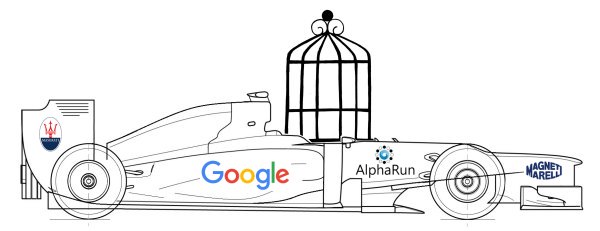|
2016
|
Google
AlphaRun to challenge Hamilton
Google’s
parent company, Alphabet, is secretly entering F1 racing. According to
an insider familiar with F1 organizer Bernie Ecclestone, Google has
agreed to purchase CVC, which owns a controlling stake in Formula One
racing. By doing so, Google will be able to rewrite the rules of F1,
allowing autopilot machines to compete with the world’s best racing
drivers on a variety of race tracks. It is expected to inject a new
lease of life into F1 racing, attracting IT-addicted young people back
to the sport.
According to the insider, a key element of the grand plan is to upgrade
Google’s artificial intelligence, AlphaGo, which famously won board
game Go against professional player Lee Se-Dol last month, into
AlphaRun, a version specialized in driving. Like the chess-playing
version, its “Deep Learning” technology is able to learn how to drive a
race car by surfing the internet, watching the video clips of legendary
racing drivers like Sterling Moss, Juan Manuel Fangio, Giles
Villeneuve, Ayrton Senna and Michael Schumacher, especially those
featuring how Senna and Schumacher bumped their rivals off track. Deep
Learning will also consult the creative driving techniques of Speed
Racer and Mr. Bean to
make sure it is able to think out of the box and beat professional
racing drivers.
To demonstrate its superiority, Google will organize 5 races against
world champion Lewis Hamilton using identical cars. They will take
place
at the most difficult tracks around the world, namely Monte Carlo,
Macau, Nurburgring Nordschleife, Pikes Peak and Beijing (if Hamilton
could survive its air). The overall winner will take big prizes
including free Android Play downloads and unlimited usage of Google
Drive, which will be extremely attractive to AlphaRun if not Hamilton.

While the autopilot system is developed by Google DeepMind, the race
car chassis is to be supplied by Ferrari. It will feature an elegant
“Birdcage” halo protection system patented by Maserati, and hopefully
this will replace the ungainly alternatives that Ferrari and Red Bull
are developing. It should satisfy FIA’s requirement for all-round
protection to the driver while providing additional sense of security,
not to
mention the unrivalled aesthetic which has been lost in Formula 1 for
so long.
In order to slash costs and save smaller teams, Google
wants to revise the rules of power unit to accept off-the-shelf
production engines. The hottest candidate is tipped to be Viper’s
8.4-liter V10, as there are lots of stocks
unsold, enough for McLaren drivers to blow up several every race.
Another likely choice is Volkswagen EA189 2.0-liter turbo diesel, whose
cheat software should be a perfect mate with AlphaRun. The poorest
teams may opt for the very cost-effective Fiat 0.9-liter
TwinAir, which may be a little bit down on power, but its characterful
noise could easily overwhelm the current F1 engines. Power output of
different engines could be levelled out by over- or underclocking
their CPUs.
To be fair to its human rivals, the Google race car will not
link the AlphaRun central brain directly to its drive-by-wire controls,
which could have eliminated reaction lags and presented an unfair
advantage. Instead, it will be driven by
a monkey through conventional steering wheel, pedals and shift paddles
on which signal lamps with banana symbol are attached. AlphaRun will
use these
signals to guide the specially trained monkey to manipulate the
controls in a skillful manner, including heel-and-toe actions of which
monkey feet are extremely capable of. Hopefully this will realize the
vaticination of Nigel Mansell made in 2002, who famously claimed that
F1 cars had become so easy to drive that even
monkeys could manage the job. How visionary Mansell was!
|
|

|

